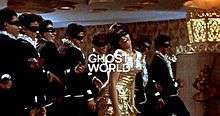Jaan Pehechan Ho
| "Jaan Pehechan Ho" | |
|---|---|
| Sung by Mohammed Rafi from the album Gumnaam | |
| Released | 1965 |
| Genre |
Filmi Indian rock Rock and roll |
| Length | 5:38 |
| Composer(s) | Shankar Jaikishan |
| Producer(s) | Shankar Jaikishan |
"Jaan Pehechan Ho" is a popular Indian rock & roll song, composed by famous Indian music director duo Shankar Jaikishan, lyrics by Shailendra, and sung by Mohammed Rafi. It was produced for the 1965 Bollywood film Gumnaam, directed by Raja Nawathe, produced by N.N. Sippy, and starring Manoj Kumar and Nanda. The song has been widely "remediated" in North American circulation.[1]
Video

The song's video was shot in a disco and features Laxmi Chhaya. The choreography was by Herman Benjamin.
Ted Lyons and His Cubs
The group "Ted Lyons and his Cubs" playing the song can also be seen in 1964 film Jaanwar playing "Dekho Ab To" (a cover version of I Want to Hold Your Hand by Beatles) and Tasveer (starring Feroz Khan), Love Marriage (starring Dev Anand), Bedaag (starring Manoj Kumar), Shehnai, and Mere Sanam (both starring Vishwajeet). The dancer/choreographer Oscar Unger can also be seen in most of them.
Popular culture
The song appears in the opening credits of the 2001 movie Ghost World. In an interview, Ghost World writer Daniel Clowes mentions that he obtained his 20th generation copy of the scene from someone who had been housesitting for Peter Holsapple, guitarist and songwriter for The dB's, and he copied it from Peter's collection. Then they approached the sons of the producers and acquired the rights to use the song in the movie. The Ghost World DVD features the entire music video from the movie.[2]
The song, with similar costumes and choreography, also appears in the Cullberg Ballet's rendition of Ekman’s Triptych.
The song was also used for Heineken's 2011 "The Date" commercial.[3][4]
In 2012, a cover of the song was included by The Bombay Royale in their debut album You Me Bullets Love.[5][6]
In the 2014 video game Far Cry 4, by Ubisoft, the song is heard playing when the character storms the main antagonist's fortress.
References
- ↑ "Novak, David. 2010. "Cosmopolitanism, Remediation, and the Ghost World of Bollywood." Cultural Anthropology 25(1):40-72.". Retrieved 9 December 2012.
- ↑ Brandi, Ralph. "And the dancing is really a substitute for sex". Retrieved 1 July 2011.
- ↑ "Ask Sam: Straight answers". Winston-Salem Journal. 2011-10-08. Retrieved 2011-10-08.
- ↑ "Heineken "The Date" commercial (2011)". Retrieved 15 November 2016.
- ↑ "The Bombay Royale, Odd Future, Chet Faker and Sean Paul". The Australian. 2012-04-12. Retrieved 2012-04-12.
- ↑ "The Bombay Royale - Jaan Pehechan Ho". Retrieved 2012-03-30.